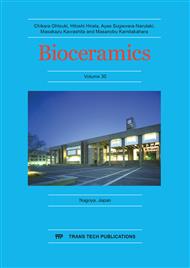[1]
Craig, R.G., W.J. O'Brien and J.M. Powers. 2002. Dental Materials Properties and Manipulation. 11th ed. St. Louis. Mosby-YearBook, Inc. Pp. 68-124, 232-257.
Google Scholar
[2]
Randolph, Luc D., Palin, W.M., Leloup, G., and Leprince, J.G. 2016. Filler Characteristics of Modern Dental Resin Composites and Their Influence on Physico Mechanical Properties. Belgium. Journal Dental Material. 2850:1-14.
DOI: 10.1016/j.dental.2016.09.034
Google Scholar
[3]
Mota, E.G., Adriano, W., Spohr, A.M., Oshima, H.M.S., and Carvalho, L.M.N. 2011. Relationship Between Filler Content and Selected Mechanichal Properties of Six Microhybrid Composite. Brazil. 26(2):151-155.
DOI: 10.1590/s1980-65232011000200010
Google Scholar
[4]
Djustiana, Nina., Hasratiningsih, Z., Karlina, E., Febrida, R., Takarini, V., Cahyanto, A., Hardiansyah, A., and Sunendar, B. 2016. Hardness Evaluation of Dental Composite with Ceramic Fillers. Key Engineering Materials. 696:74-79.
DOI: 10.4028/www.scientific.net/kem.696.74
Google Scholar
[5]
Chen, Liang., Yu Qingsong; Wang Yong; and Haoli. 2011. BisGMA/TEGDMA Dental Composite Containing High Aspect Ratio Hydroxyapatite Nanofibers. United States. Journal Dental Material. 27(11):1187-1195.
DOI: 10.1016/j.dental.2011.08.403
Google Scholar
[6]
Mousavinasab, S.M. 2011. Effect of Filler Content on Mechanical and Optical properties of Dental Composite Resin. Iran. Journal Dental Material. 421-425.
Google Scholar
[7]
Aruniit, A., Kers J., and Tall K. 2011. Influence of Filler Proportion on Mechanical and Physical Properties of Particulate Composite. Estonia. Agronomy Research. 1:23-29.
Google Scholar
[8]
Shahdad, Shakeel A., McCabe, John F., Bull, Steven., Rusby, Sandra., and Wassel, Robert W. 2007. Hardness Measured with Traditional Vickers and Martens Hardness Method. UK. Journal Dental Material. 23:1079-1085.
DOI: 10.1016/j.dental.2006.10.001
Google Scholar
[9]
Faza, Y, Hasratiningsih Z, harmaji A, Joni I M, preparation and characterization of zirconia-alumina system via solution and solid phase mixing method. AIP Conference Proceedings 1927, 030030 (2018).
DOI: 10.1063/1.5021223
Google Scholar
[10]
Hasratiningsih Z, Takarini V, Cahyanto A, Faza Y, Asri L A T W, Purwasasmita B S, hardness evaluation of PMMA reinforced with two different calcination temperatures of ZrO2-Al2O3-SiO2 filler system. 2017 IOP Conf. Ser.: Mater. Sci. Eng. 172 012067.
DOI: 10.1088/1757-899x/172/1/012067
Google Scholar
[11]
Djustiana, N, Greviana N, Faza Y, Sunarso, synthesis and characterization of dental composite. AIP Conference Proceedings 1927, 020003 (2018).
DOI: 10.1063/1.5021191
Google Scholar
[12]
Djustiana N, Febrida R, Panatarani C, Imarundha Y, Karlina E, Joni I M, Microstructure analysis of zirconia-alumina-silica particles made from indonesia natural sand synthesized using spray pyrolysis method. 2017, Key Engineering Materials, Vol. 720, pp.285-289.
DOI: 10.4028/www.scientific.net/kem.720.285
Google Scholar
[13]
Hasratiningsih, Z., et al. 2016. Basic properties of PMMA reinforced using ceramics particles of ZrO2-Al2O3-SiO2 coated with two types of coupling agents. Trans Tech Publications, pp.93-98.
Google Scholar
[14]
Bielinski, D.M., and Ranganathan, N. 2011. Material Aspects of Exploitation of Dental Composites Based on Dimethacrylate Resins. Germany. Literatur Review.
Google Scholar
[15]
Lucas, T.J., Lawson, N.C., Janowski, G.M., and Burgess, J.O. 2015. Effect of Grain Size on the Monoclinic Transformation, Hardness, Rourhness, and Modulus of Aged Partially Stabilized Zirconia. United States. Journal Dental Material. 31:1487-1492.
DOI: 10.1016/j.dental.2015.09.014
Google Scholar
[16]
Touaiher, I., Saadaoui, M., Chevalier, J., and Reveron, H. 2016. Effect of Loading Configuration on Strength Values in A Highly Transformable Zirconia-Based Composite. France. Journal Dental Material. 32:e211-e219.
DOI: 10.1016/j.dental.2016.06.023
Google Scholar
[17]
Partoon B., Sabil K.M., Roslan H., Lal B., and Keong L.K. 2016. Impact of Acetone on Phase Boundary of Methane and Carbon Dioxide Mixed Hydrates. Malaysia. Fluid Phase Equilibria Journal. 412:51-56.
DOI: 10.1016/j.fluid.2015.12.027
Google Scholar


